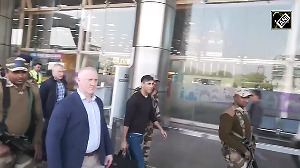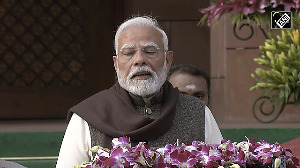"We did not received any demand from any of the terrorists," NSG Director General Jyoti Kishan Dutt said.
He also refuted charges that the terrorists had planned to blow up the 105-year-old Taj heritage hotel, repeating the Marriott hotel explosion in Islamabad in September.
"The terrorists did not appear to have plans to blow up the Taj as they lacked enough explosives," Dutt said, after returning to New Delhi from successfully executing the operations in the financial capital of the country.
The elite force lost two commandos -- Major Sandeep Unnikrishnan and Havildar Gajendra Singh -- while eight others were injured during its counter-offensive against terrorists in two of the three locations that witnessed the worst-ever terrorist sieges in the country.
Lauding his teams, Dutt said both his men made supreme sacrifices and displayed gallant acts while they continued their offensive against the terrorists who were firing indiscriminately from an advantageous position.
In Operation Cyclone carried out in the century-old Taj hotel, Major Sandeep Unnikrishnan laid down its life while trying to save the life of his comrade, who was injured in the firing.
"He was able to push him from the ladder to safety...One of the terrorists lobbed a hand grenade on them as a result of which he (Major Unnikrishnan) was separated from his team."
"Instead of coming down, he went up from where terrorists were firing. He went up and returned the fire. He also warned the party, which was coming in for his rescue, fearing that they would be caught in a crossfire," Dutt said.
Meanwhile, the Lashkar-e-Tayiba, which is said to have carried out the terror strikes in Mumbai, has for the first time used Hindi words while conveying their threat message through media houses.
Interestingly, the mail, sent in the name of the Deccan Mujahideen, was generated from an e-mail account created in Russia, but used by a computer based in Pakistan, officers investigating the November 26 attack said.
The author of the mail had used voice recognition software to dictate the mail which would in turn type it in Devnagri font.
Officials handling counter-insurgency operations in the country said that militants had not only for the first time used Hindi but also made the mail jump from one server to another in order to hide the identity of the master server.
Computer experts say the e-mail, claiming responsibility for Wednesday's terror attacks, was first generated on a computer located in Pakistan.
Analysing the Internet Protocol addresses used to send the mail, the experts found that the Russia-based e-mail address used to send the document was opened early on November 26 by a computer user in Pakistan.
While this mail has been found to be a milder version of what had been received after the previous serial blasts from the Indian Mujahideen, the tone and tenor was quite similar to the 'hate-India' mails generated earlier.
'Chetavani nahi haqeekat....(This is not a threat but a fact) was the screaming headline of the two-page e-mail sent to some media houses after the terror strike. The Lashkar militants had used some typical Hindi words like 'kriya' (action), 'pratikriya' (reaction) and 'udhaharan' (example).






 © 2025
© 2025